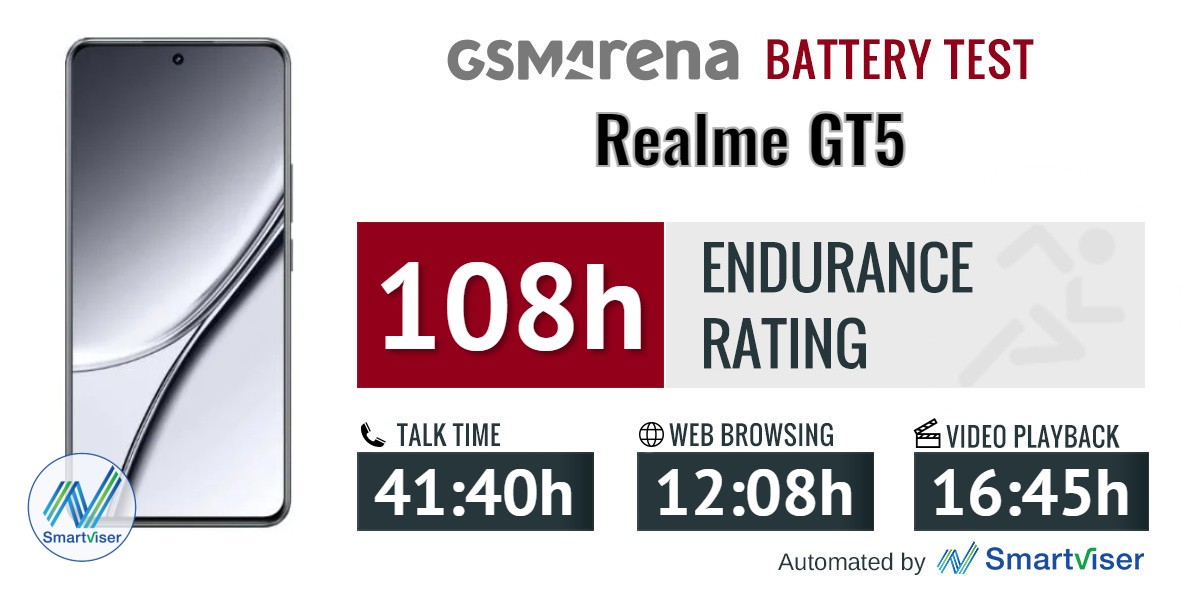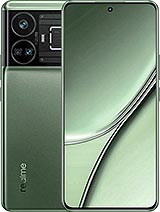Realme GT5 240W review

Fast, bright and crisp OLED
The Realme GT5 recycles last year's GT3 display, which is hardly an issue here as the panel is flagship-level by all accounts. It's a big one, measuring 6.74" in diagonal, but has a bit higher resolution to match - 1,240 x 2,772px. The panel also supports 144Hz refresh rate, which is a bit higher than the industry standard of 120Hz, has 10-bit color depth and supports HDR10+ content.

In our brightness test, the screen peaked at 1,100 nits in auto mode and reached 483 nits in manual mode - almost identical to last year's results, suggesting that Realme used the same panel for this year's GT5. We don't consider this an issue, though, because it's an excellent screen to begin with.
When it comes to color accuracy, the default color mode isn't the best option, as the whites and grays are quite blue-ish. Opting for the so-called Normal mode improves color accuracy significantly and lowers the average dE2000 down to 0.9.
HRR control
The HRR control is a bit of a mess. There are three modes - Auto, Standard and High refresh rate settings. They are pretty self-explanatory, but in Auto, most system and third-party apps were locked at 60Hz or 120Hz at best. Only Google Chrome was able to saturate the full 144Hz. In fact, the refresh rate didn't go beyond 120Hz, even in system menus. The good news is that the software is extremely quick to switch between 60 and 120Hz when leaving the display idle.
Switching over to High refresh rate mode will lock pretty much everything in 120Hz. The software won't dial down to 60Hz, either. There's even a sub-menu allowing you to select between 60, 120 and 144Hz on per app basis. Interestingly enough, only a handful of apps were "clocked" at 144Hz by default. Either way, this isn't a good solution to the issue, as a constant 120Hz (or 144Hz) refresh rate will drain the battery faster.
Battery life
This year's GT5 240W comes with the same 4,600 mAh battery capacity as last year, but the 150W option gets a bigger 5,000 mAh unit. And while we expected similar battery endurance to last year's model, we got slightly worse results in all tests. The screen-on and screen-off tests show a noticeable decline in battery endurance, so the overall score is 108 hours. This isn't a bad result on its own, but it's less than what we expected.

Our battery tests were automated thanks to SmartViser, using its viSerDevice app. The endurance rating denotes how long the battery charge will last you if you use the device for an hour of telephony, web browsing, and video playback daily. More details can be found here.
The reason for this is unknown, but it could be due to the chipset, as it's the only notable change in the setup. Still, the software could play a big role in it too.
Video test carried out in 60Hz refresh rate mode. Web browsing test done at the display's highest refresh rate whenever possible. Refer to the respective reviews for specifics. To adjust the endurance rating formula to match your own usage patterns check out our all-time battery test results chart where you can also find all phones we've tested.
Charging speed
The Realme GT5 comes in two versions - a standard Realme GT5 with 150W fast charging and a 240W variant. Expectedly, the 4,600 mAh battery takes the same time to charge as last year's GT3. The handset completed a full 0-100% charging cycle in just 12 minutes, which is just a minute more than the Realme GT3. Well within the margin of a statistical error.
And here's how the charging curve looks throughout the whole test.

Keep in mind, however, that the room temperature is of great importance. The system seems way too sensitive to ambient temperature and could throttle. Still, even if it's slower than 12 minutes, the GT5 is capable of completing the cycle within 20 minutes, which is extremely fast anyway.
Speakers
The Realme GT5 features a standard speaker setup - one placed behind the earpiece grille as it acts as an earpiece, too, while the other is a bottom-firing one. This means that the bottom speaker is a bit louder than the other one, but that's expected.
Loudness has improved over last year's GT3 with a "Very Good" loudness score of -25.7 LUFS. Tuning and overall quality haven't changed, though. It provides clean enough sound with distinctive vocals, nice bass and little distortion at higher levels.
Use the Playback controls to listen to the phone sample recordings (best use headphones). We measure the average loudness of the speakers in LUFS. A lower absolute value means a louder sound. A look at the frequency response chart will tell you how far off the ideal "0db" flat line is the reproduction of the bass, treble, and mid frequencies. You can add more phones to compare how they differ. The scores and ratings are not comparable with our older loudspeaker test. Learn more about how we test here.
Reader comments
- Bottles
- 02 May 2024
- RJi
Been using gt5 240w 16/512gb for 2 weeks now. Everything else works phenomenal. Loved the charging speed the most. Approximately less than 10 minutes can charged up the phone from 10% to 100%. Safe me a lot of times during rushing hours. A real game ...
- Vijay
- 23 Feb 2024
- tTf
When it's going release in India
- Bval
- 07 Feb 2024
- NfK
It's not the same. The realme GT5 tested here have 4600 mah and 240 W charger. The regular GT5 have 5240 mah and 150W





